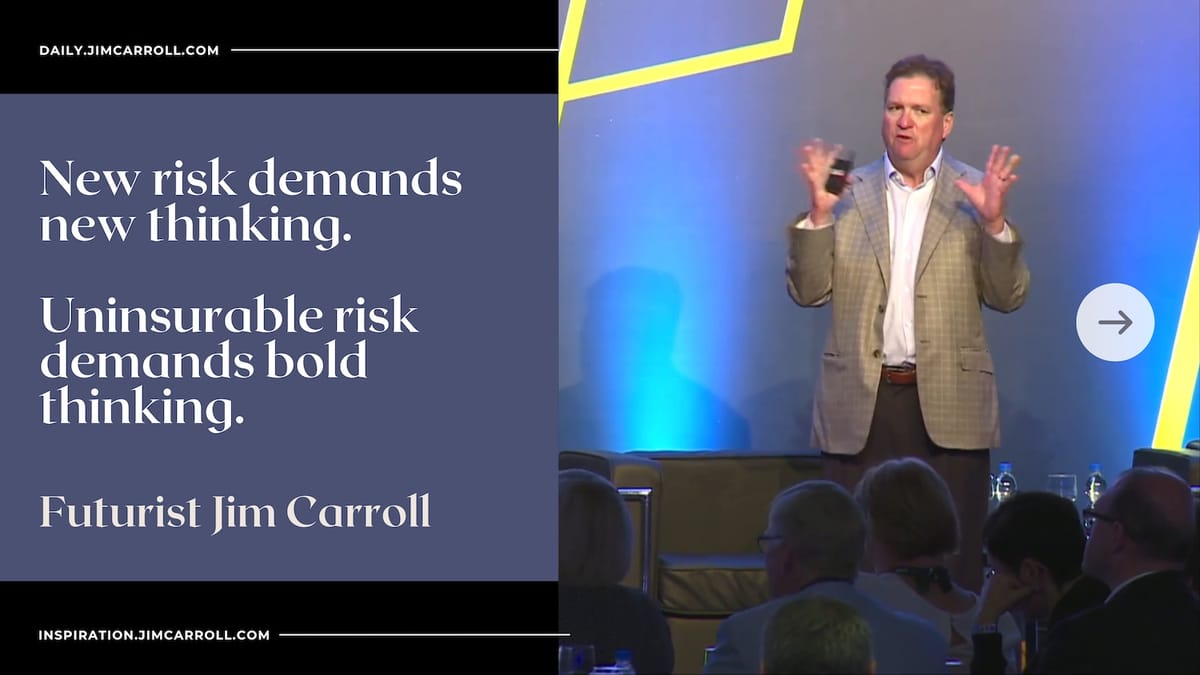"New risk demands new thinking. Uninsurable risk demands bold thinking." - Futurist Jim Carroll
In just about a month, I'll head to California to headline a major insurance conference. The fact that I'm speaking in a region that is home to one of the largest insurance losses in US history is not lost on me, and in fact, will provide form for much of my talk. Loosely structured, I will be focusing on 'the future of risk.'
The fact is, I've done this talk on numerous occasions over the years. Not trying to boast, but I've done keynotes or have led leadership meetings for a vast array of insurance companies over the years. Some time ago, another company asked for such a list. Ok, here goes: Manulife, SunLife, New York Life, Harvard Pilgrim Healthcare, RBC Insurance, Cigna, Hartford Life, Farmers, MetLife, Lincoln Financial, Towers Perrin, RGA Reinsurance, Magellan Health, Gore Mutual, Economical Insurance, Chubb, the American Fidelity Group, Providence Health Plans, Aegeon, Blue Cross/Blue Shield US (multiple events) and CGU Insurance – and even a private event, invite-only event where he had the CIOs/CFOs/CTOs for Allianz, XL Insurance, Travellers, Zurich, Allstate, AXA, MetLife Auto & Home, Farmers, CNA, ICICI Lombard, Nationwide, American Family, Chubb, Ping An, Lloyds of London, Liberty Mutual, The Hartford, General, USAA, Geico, ACE, State Farm, Progressive, RSA. I think there were many others!
Anyways, back to the issue. Here's a good example of something I posted in March 2007:
Back to work, and I’m off to San Antonio, Texas, to keynote the Property and Casualty Insurers Association of America Joint Underwriting/Marketing conference.
I’ll be speaking to them on the broad theme of the “future of risk;” what unique new risks might we face in society as we go forward? I look at technological, social, demographic, international, bio/health care issues, and a wide variety of other trends that are changing our ideas about risk.
The session description reads:
In today’s high-velocity economy, it’s all about rapid time to market balanced by appropriate underwriting caution. The insurance industry today is immersed in a period of unprecedented, relentless change; impacted by hyper-innovation, fast-paced technological evolution, the rapid emergence of new forms of risk, and increasing business market turmoil. Permanence has been torn asunder, as customers and business organizations empower themselves with information, and as underwriting decisions become ever more complex. In an era such as this, every insurance organization needs to ensure that they are focused on the concepts of “agility, insight, and execution.” The way to the future is clear: it’s no longer about simple risk management: it’s about having the flexibility to adapt to rapidly changing circumstances; the insight to spot emerging new forms before they impact the bottom line; and operational excellence in deployment of new insurance products based on sound, reliable underwriting. Join international futurist, trends, and innovation expert Jim Carroll, as he shares his insight into how organizations are focused on management strategies that focus on agility, insight, and execution.
You get the idea. My generic insurance keynote topic - the teaser that draws an executive in the door - reads like this:
Insurance in the Era of Disruption: The Challenge of Change with Fintech, Accelerated Risk and Hyper-Connectivity
The world of insurance is being transformed at a pace that defines new opportunities, presents new challenges, and turns the established order upside down. It also challenges every assumption the industry has made. You need a real expert – with real insight – into the trends that are underway.
The industry is being rapidly disrupted by tech companies. Existing brokerage and distribution networks will be obliterated as more people buy insurance directly. Predictive analytics will shift the industry away from actuarial-based historical assessment to real-time coverage. Policy niches, micro-insurance, and just-in-time insurance will drive an increasing number of revenue models. The Internet of Things (IoT) and massive connectivity will provide for massive market and business model disruption. Fast-paced trends involving self-driving cars, the sharing economy, personal drones, swarm-bots, smart dust, artificial intelligence, and augmented reality will either mitigate, accelerate or challenge the very notion of risk assessment and underwriting!
What happens when Amazon, Google, or some kid in a garage decides to change the insurance business model?
And then there is the element of risk itself – at a recent global insurance risk summit in Switzerland, Jim Carroll outlined the dramatic new forms of accelerated risk that the industry must now confront. What seemed to be science fiction just a few short years ago has become a reality today, as time compresses and the future accelerates.
Whichever way you look, all sectors of the insurance industry are set for an era of disruption, challenge, and change! Is the industry ready for transformative change? Not really! A recent survey indicated that while 94% of Chief Strategy Officers at insurance companies agree that tech will “rapidly change their industry in 5 years,” fewer than 1 in 5 CSOs believe their companies are prepared. Does the insurance industry have the innovation culture necessary to deal with the potential for what comes next?
Maybe not.
Jim Carroll has been assisting insurance organizations around the world to understand the tsunami of change that is underway: the rapid business emergence of new business models, accelerated risk, the emergence of new global competitors, and heightened customer expectations. In his keynotes he puts into perspective the real trends impacting the future of insurance, offering critical insight into the key innovation and leadership strategies in a time of disruptive change, as well as clear, action-oriented strategic insight that will compel you to action.
Anyways, back to the issue of today's quote. Think about it - for years I've been indicating that clearly, new risk demands new thinking. But we are now in the midst of a massive new trend - one in which uninsurable risk demands bold thinking. The fact is, the insurance industry finds itself at a pivotal moment where traditional models are colliding with accelerating risk. The very foundations of insurability are being challenged by climate, technology, and societal shifts.
But in every challenge lies opportunity - and here's where the bold thinking comes in,
Think about what's happening right now: Coastal property insurance is collapsing in regions where rising seas meet increasing storm intensity. Traditional auto insurance is being disrupted by the connected car. Pandemic risk coverage is being fundamentally reshaped by vaccine hesitancy and emerging pathogens. Supply chain interruption insurance is desperately trying to keep up with a world where 'just-in-time' meets 'constant disruption' and where the mad whims of the delusional destroy global commerce. Carbon emission insurance is attempting to price risks that didn't even exist a decade ago.
The risks of uninsurable risk are real. In Florida, major insurers are pulling out faster than a speedboat in a hurricane. In California, wildfire zones that were once easily insurable are now insurance deserts. The cyber insurance market is dealing with risks that evolve not yearly or monthly, but hourly. Environmental liability insurance is grappling with contaminants we haven't even discovered yet. There are entire population zones that will see a decrease in life expectancy due to healthcare denialism - and the current political climate will simply accelerate that trend.
These aren't just changes - they're seismic shifts in the insurance landscape. But here's where it gets interesting.
Every one of these challenges is pushing us toward new solutions that are as innovative as the risks they address:
- Parametric Insurance Products are the ultimate velocity play - they're insurance at the speed of risk. When a Category 5 hurricane is bearing down, you don't have time for adjusters and paperwork. These products say 'If X happens, you get Y - instantly.' It's the Netflix of insurance - immediate, digital, frictionless. We're moving from 'assess and pay' to 'trigger and transfer.' This isn't just innovation; it's insurance at the speed of tomorrow.
- Hybrid Coverage Solutions represent the fusion mindset we desperately need. Think of them as the insurance equivalent of a hybrid car - combining the best of multiple technologies to achieve what neither could do alone. When traditional coverage hits the wall, these solutions break through it by combining multiple risk transfer mechanisms. They're the ultimate insurance mashup, and they're letting us insure the previously uninsurable.
- Risk-sharing Pools are the collaborative future in action. In an era where individual companies can't shoulder massive systemic risks alone, these pools are creating strength through unity. It's the sharing economy that meets insurance-distributed risk for a distributed world. We're seeing the emergence of what I call 'risk cooperatives' that can tackle everything from autonomous vehicle fleets to space tourism.
- Public-private Partnerships are rewriting the rules of what's possible. When private markets say 'no way,' these partnerships say 'let's find a way.' They're the ultimate example of what I call 'possibility thinking' - combining the innovation engine of private enterprise with the stability and scale of government. This isn't just risk transfer; it's risk transformation through collaboration.
- Behavior-based Pricing Models represent the gamification of risk. They're turning passive policyholders into active risk managers. Through real-time monitoring and instant feedback, we're creating what I call 'insurance athletes' - people and organizations actively competing to lower their risk profile. It's the Peloton model applied to insurance - making risk management engaging, competitive, and rewarding. John Hancock is doing this with its Vitality insurance product.
Here's the thing about uninsurable risk - it's not uninsurable. It's just waiting for the right innovative approach. This isn't about tweaking the old models; it's about fundamentally reimagining how we think about risk transfer in an age of exponential change. These solutions aren't just patches on an old system - they're the building blocks of Insurance 2.0 3.0 or 4.0, where risk becomes an opportunity for innovation rather than a barrier to progress.
And remember: in the world of accelerating risk, standing still is moving backward.
The only way forward is through bold, decisive innovation that matches the velocity of change we're experiencing.
Futurist Jim Carroll takes on highly complex topics in his industry-specific keynotes.

